Corporate Social Responsibility: NOKIA Case Study Analysis Report
VerifiedAdded on 2021/09/08
|14
|4471
|163
Report
AI Summary
This report delves into the concept of Corporate Social Responsibility (CSR), examining its significance and impact on businesses. It begins with an introduction to CSR, emphasizing its role in integrating environmental and social concerns into business operations, and the benefits it offers, such as improved public image and employee engagement. The report then transitions into a literature review, exploring various CSR models and theories, including the pyramid model, intersecting circles model, and concentric circle model, as well as discussions on stakeholder management, transparency, and the strategic benefits of CSR. The core of the report is an analysis of the NOKIA case study, highlighting the challenges NOKIA faced related to customer satisfaction due to its choice of the Windows operating system over Android. The analysis underscores the critical importance of customer satisfaction as a key CSR activity. The report concludes by summarizing the key findings, emphasizing the need for companies to prioritize stakeholder management, especially customers, to ensure long-term success and avoid significant market losses. The report aims to provide a comprehensive understanding of CSR principles and their practical implications through the lens of the NOKIA case study.
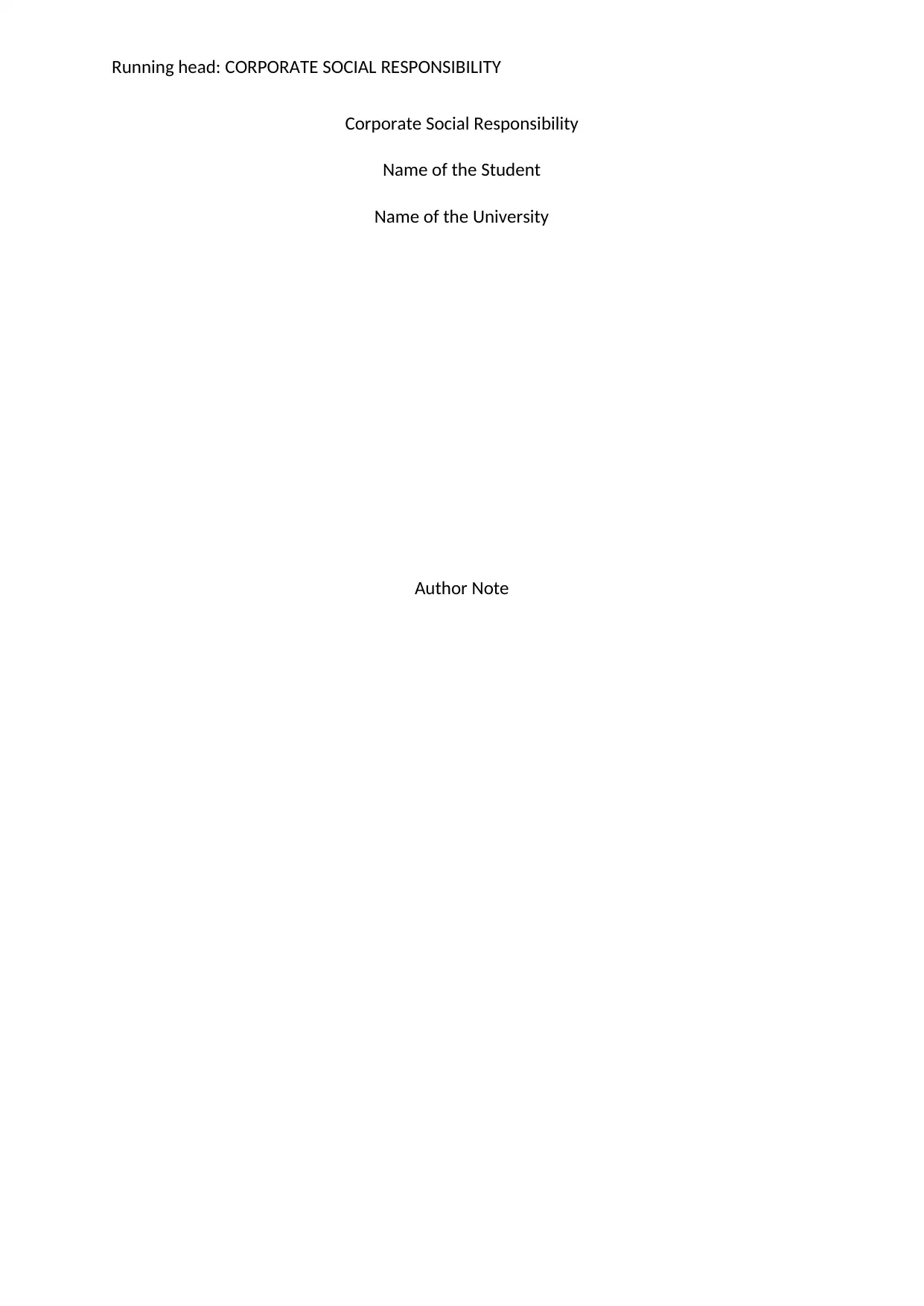
Running head: CORPORATE SOCIAL RESPONSIBILITY
Corporate Social Responsibility
Name of the Student
Name of the University
Author Note
Corporate Social Responsibility
Name of the Student
Name of the University
Author Note
Paraphrase This Document
Need a fresh take? Get an instant paraphrase of this document with our AI Paraphraser

1CORPORATE SOCIAL RESPONSIBILITY
Table of Contents
Introduction:..............................................................................................................................2
Literature Review:......................................................................................................................3
Analysis of the NOKIA Case Study:.............................................................................................6
Discussion and Conclusion:........................................................................................................9
References:...............................................................................................................................12
Table of Contents
Introduction:..............................................................................................................................2
Literature Review:......................................................................................................................3
Analysis of the NOKIA Case Study:.............................................................................................6
Discussion and Conclusion:........................................................................................................9
References:...............................................................................................................................12

2CORPORATE SOCIAL RESPONSIBILITY
Introduction:
The CSR or the Corporate Social Responsibility is a management concept in which
the organizations include the environmental and social concerns in the business of them
(Schwartz 2017). Also, the stakeholder interactions are integrated into the business
operations. The CSR can benefit an organization or a company in a variety of ways. The
Corporate Social Responsibility helps the organization to improve its public image, increase
the coverage of media, boosts engagement of employees and retains and attracts new
investors for the organization (MARKET 2018). Though the CSR provides various benefits to
the organization, it has several key issues also. The organization faces several issues
regarding the CSR which includes eco-efficiency, stakeholder management, working
conditions, labour standards and environmental management.
In this document for critically review the corporate social responsibility, the case
study of NOKIA has been selected. While evaluating the case study of the NOKIA the main
challenges found regarding the CSR is the stakeholder management challenge. In this case,
the stakeholder was the customers. The chosen challenge is very much significant in this
case because the customer is the most important aspect in every organisation. Without
proper customer service and satisfaction, the organisation will not generate any type of
revenue as most of the profit comes from the customers.
The main reason behind choosing the case of the NOKIA is elaborating the
significance of the corporate social responsibility. In the past, it was seen that the NOKIA
faced a huge loss in the market due to choosing the Windows operating system over the
Android operating system for their mobile devices. Due to the selection of the Windows
operating system they were not able to provide the vast functionality which was provided
by the Android operating system at that time. For this reason, the customers of the NOKIA
remains unsatisfied when they compared themselves with the Android users, and due to
this, the NOKIA faced a huge loss in the international market. For this reason, in this
document the case study of the NOKIA has been selected with the consumer or customer
stakeholder.
Introduction:
The CSR or the Corporate Social Responsibility is a management concept in which
the organizations include the environmental and social concerns in the business of them
(Schwartz 2017). Also, the stakeholder interactions are integrated into the business
operations. The CSR can benefit an organization or a company in a variety of ways. The
Corporate Social Responsibility helps the organization to improve its public image, increase
the coverage of media, boosts engagement of employees and retains and attracts new
investors for the organization (MARKET 2018). Though the CSR provides various benefits to
the organization, it has several key issues also. The organization faces several issues
regarding the CSR which includes eco-efficiency, stakeholder management, working
conditions, labour standards and environmental management.
In this document for critically review the corporate social responsibility, the case
study of NOKIA has been selected. While evaluating the case study of the NOKIA the main
challenges found regarding the CSR is the stakeholder management challenge. In this case,
the stakeholder was the customers. The chosen challenge is very much significant in this
case because the customer is the most important aspect in every organisation. Without
proper customer service and satisfaction, the organisation will not generate any type of
revenue as most of the profit comes from the customers.
The main reason behind choosing the case of the NOKIA is elaborating the
significance of the corporate social responsibility. In the past, it was seen that the NOKIA
faced a huge loss in the market due to choosing the Windows operating system over the
Android operating system for their mobile devices. Due to the selection of the Windows
operating system they were not able to provide the vast functionality which was provided
by the Android operating system at that time. For this reason, the customers of the NOKIA
remains unsatisfied when they compared themselves with the Android users, and due to
this, the NOKIA faced a huge loss in the international market. For this reason, in this
document the case study of the NOKIA has been selected with the consumer or customer
stakeholder.
⊘ This is a preview!⊘
Do you want full access?
Subscribe today to unlock all pages.

Trusted by 1+ million students worldwide

3CORPORATE SOCIAL RESPONSIBILITY
Literature Review:
According to the Tai and Chuang (2014), the implementation and the perspective of
Corporate Social Responsibility or the CSR have several important significances for big and
multinational enterprises. This importance is related with the FDI in the fostering
development. All the implications have been addressed by the authors who have paid
attention to the passive and active ways of the CSR. In this way, the Pre-MNEs and the MNEs
are affected in sustainable development. As per the authors, the CSR generally influenced by
four type of core components. These four components are the competitiveness,
accountability, responsibility and transparency. The authors as showed the highlights the
role of the information asymmetry and how the corporate social responsibility will be
integrated into the organization's strategy of the differentiation.”
According to Carroll (1996), the pyramid model of the CSR can embrace the whole
spectrum of expectation of the society in the aspect of the business responsibilities. The
corporate social responsibility is now represented as a language and has become very much
vital. This has become vital in the sense that modern businesses need to make more money
by obeying corporate rules. In this literature, the author has stated that the CSR’s nature is
taking an approach related managerial decisions. In the formulation of the pyramid
structure CSR basically acts as accommodative. In the modern movement of the CSR, the
most important precursors place is taken by the emergence of social movements. As per the
author the structure of the pyramid can be considered as the conjunction of different
domains related with responsibility. The author stated the research implication of the CSR’s
pyramid model that it act as a platform in which major research developments are done. For
the research purpose most widely used research tool is the constant-sum instrument in the
CSR pyramid which was deployed by the Aupperle.
Literature Review:
According to the Tai and Chuang (2014), the implementation and the perspective of
Corporate Social Responsibility or the CSR have several important significances for big and
multinational enterprises. This importance is related with the FDI in the fostering
development. All the implications have been addressed by the authors who have paid
attention to the passive and active ways of the CSR. In this way, the Pre-MNEs and the MNEs
are affected in sustainable development. As per the authors, the CSR generally influenced by
four type of core components. These four components are the competitiveness,
accountability, responsibility and transparency. The authors as showed the highlights the
role of the information asymmetry and how the corporate social responsibility will be
integrated into the organization's strategy of the differentiation.”
According to Carroll (1996), the pyramid model of the CSR can embrace the whole
spectrum of expectation of the society in the aspect of the business responsibilities. The
corporate social responsibility is now represented as a language and has become very much
vital. This has become vital in the sense that modern businesses need to make more money
by obeying corporate rules. In this literature, the author has stated that the CSR’s nature is
taking an approach related managerial decisions. In the formulation of the pyramid
structure CSR basically acts as accommodative. In the modern movement of the CSR, the
most important precursors place is taken by the emergence of social movements. As per the
author the structure of the pyramid can be considered as the conjunction of different
domains related with responsibility. The author stated the research implication of the CSR’s
pyramid model that it act as a platform in which major research developments are done. For
the research purpose most widely used research tool is the constant-sum instrument in the
CSR pyramid which was deployed by the Aupperle.
Paraphrase This Document
Need a fresh take? Get an instant paraphrase of this document with our AI Paraphraser
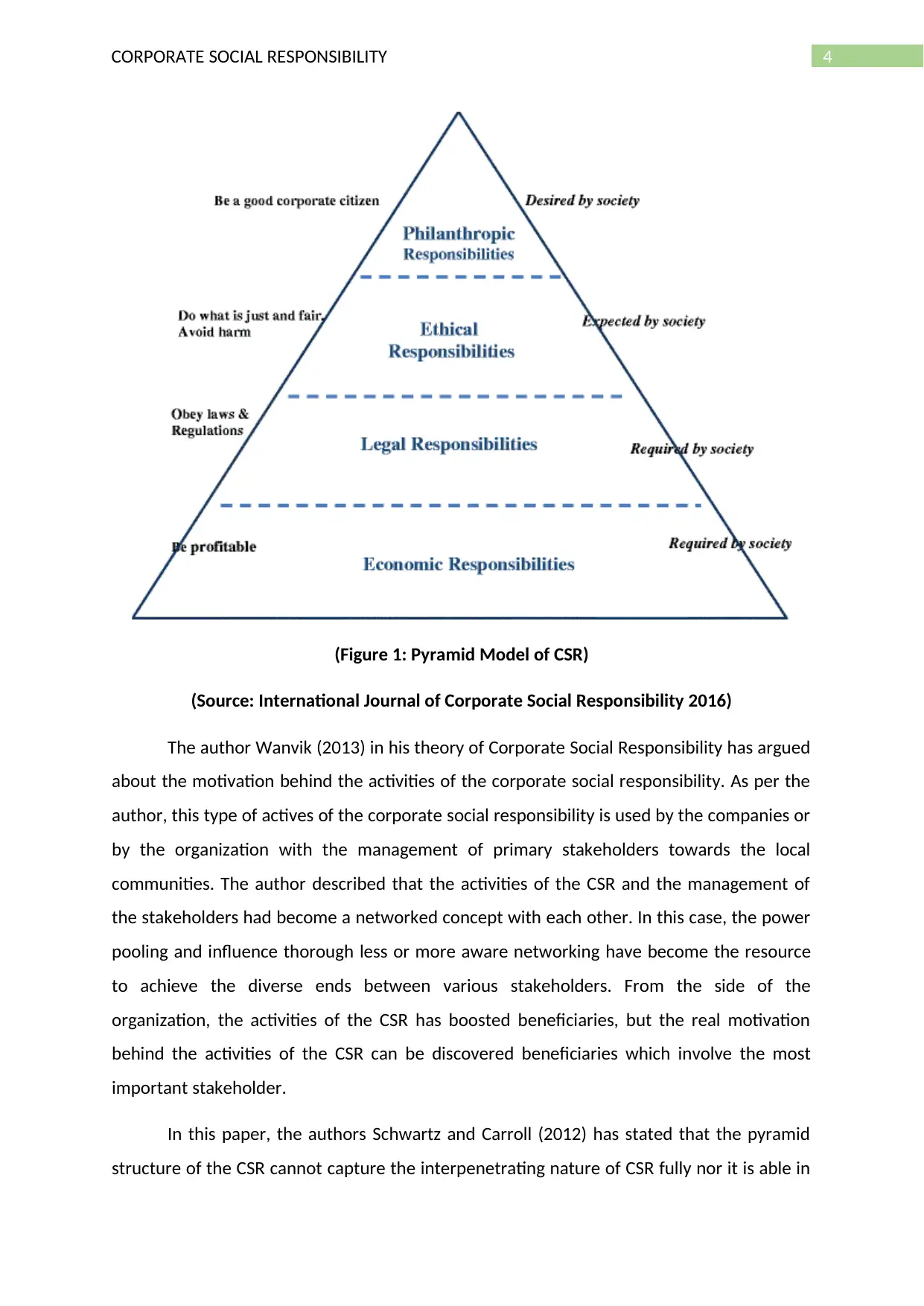
4CORPORATE SOCIAL RESPONSIBILITY
(Figure 1: Pyramid Model of CSR)
(Source: International Journal of Corporate Social Responsibility 2016)
The author Wanvik (2013) in his theory of Corporate Social Responsibility has argued
about the motivation behind the activities of the corporate social responsibility. As per the
author, this type of actives of the corporate social responsibility is used by the companies or
by the organization with the management of primary stakeholders towards the local
communities. The author described that the activities of the CSR and the management of
the stakeholders had become a networked concept with each other. In this case, the power
pooling and influence thorough less or more aware networking have become the resource
to achieve the diverse ends between various stakeholders. From the side of the
organization, the activities of the CSR has boosted beneficiaries, but the real motivation
behind the activities of the CSR can be discovered beneficiaries which involve the most
important stakeholder.
In this paper, the authors Schwartz and Carroll (2012) has stated that the pyramid
structure of the CSR cannot capture the interpenetrating nature of CSR fully nor it is able in
(Figure 1: Pyramid Model of CSR)
(Source: International Journal of Corporate Social Responsibility 2016)
The author Wanvik (2013) in his theory of Corporate Social Responsibility has argued
about the motivation behind the activities of the corporate social responsibility. As per the
author, this type of actives of the corporate social responsibility is used by the companies or
by the organization with the management of primary stakeholders towards the local
communities. The author described that the activities of the CSR and the management of
the stakeholders had become a networked concept with each other. In this case, the power
pooling and influence thorough less or more aware networking have become the resource
to achieve the diverse ends between various stakeholders. From the side of the
organization, the activities of the CSR has boosted beneficiaries, but the real motivation
behind the activities of the CSR can be discovered beneficiaries which involve the most
important stakeholder.
In this paper, the authors Schwartz and Carroll (2012) has stated that the pyramid
structure of the CSR cannot capture the interpenetrating nature of CSR fully nor it is able in
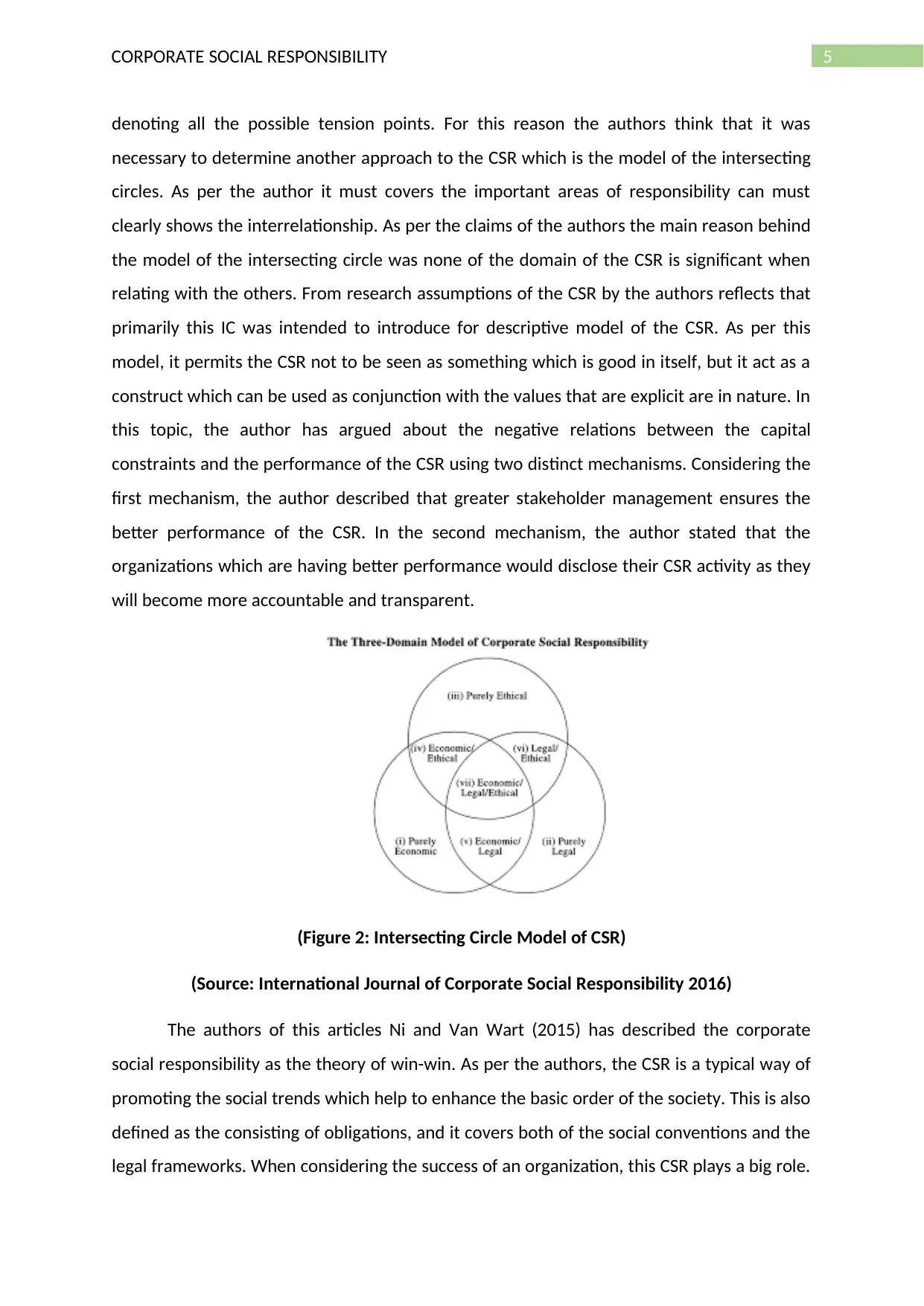
5CORPORATE SOCIAL RESPONSIBILITY
denoting all the possible tension points. For this reason the authors think that it was
necessary to determine another approach to the CSR which is the model of the intersecting
circles. As per the author it must covers the important areas of responsibility can must
clearly shows the interrelationship. As per the claims of the authors the main reason behind
the model of the intersecting circle was none of the domain of the CSR is significant when
relating with the others. From research assumptions of the CSR by the authors reflects that
primarily this IC was intended to introduce for descriptive model of the CSR. As per this
model, it permits the CSR not to be seen as something which is good in itself, but it act as a
construct which can be used as conjunction with the values that are explicit are in nature. In
this topic, the author has argued about the negative relations between the capital
constraints and the performance of the CSR using two distinct mechanisms. Considering the
first mechanism, the author described that greater stakeholder management ensures the
better performance of the CSR. In the second mechanism, the author stated that the
organizations which are having better performance would disclose their CSR activity as they
will become more accountable and transparent.
(Figure 2: Intersecting Circle Model of CSR)
(Source: International Journal of Corporate Social Responsibility 2016)
The authors of this articles Ni and Van Wart (2015) has described the corporate
social responsibility as the theory of win-win. As per the authors, the CSR is a typical way of
promoting the social trends which help to enhance the basic order of the society. This is also
defined as the consisting of obligations, and it covers both of the social conventions and the
legal frameworks. When considering the success of an organization, this CSR plays a big role.
denoting all the possible tension points. For this reason the authors think that it was
necessary to determine another approach to the CSR which is the model of the intersecting
circles. As per the author it must covers the important areas of responsibility can must
clearly shows the interrelationship. As per the claims of the authors the main reason behind
the model of the intersecting circle was none of the domain of the CSR is significant when
relating with the others. From research assumptions of the CSR by the authors reflects that
primarily this IC was intended to introduce for descriptive model of the CSR. As per this
model, it permits the CSR not to be seen as something which is good in itself, but it act as a
construct which can be used as conjunction with the values that are explicit are in nature. In
this topic, the author has argued about the negative relations between the capital
constraints and the performance of the CSR using two distinct mechanisms. Considering the
first mechanism, the author described that greater stakeholder management ensures the
better performance of the CSR. In the second mechanism, the author stated that the
organizations which are having better performance would disclose their CSR activity as they
will become more accountable and transparent.
(Figure 2: Intersecting Circle Model of CSR)
(Source: International Journal of Corporate Social Responsibility 2016)
The authors of this articles Ni and Van Wart (2015) has described the corporate
social responsibility as the theory of win-win. As per the authors, the CSR is a typical way of
promoting the social trends which help to enhance the basic order of the society. This is also
defined as the consisting of obligations, and it covers both of the social conventions and the
legal frameworks. When considering the success of an organization, this CSR plays a big role.
⊘ This is a preview!⊘
Do you want full access?
Subscribe today to unlock all pages.

Trusted by 1+ million students worldwide
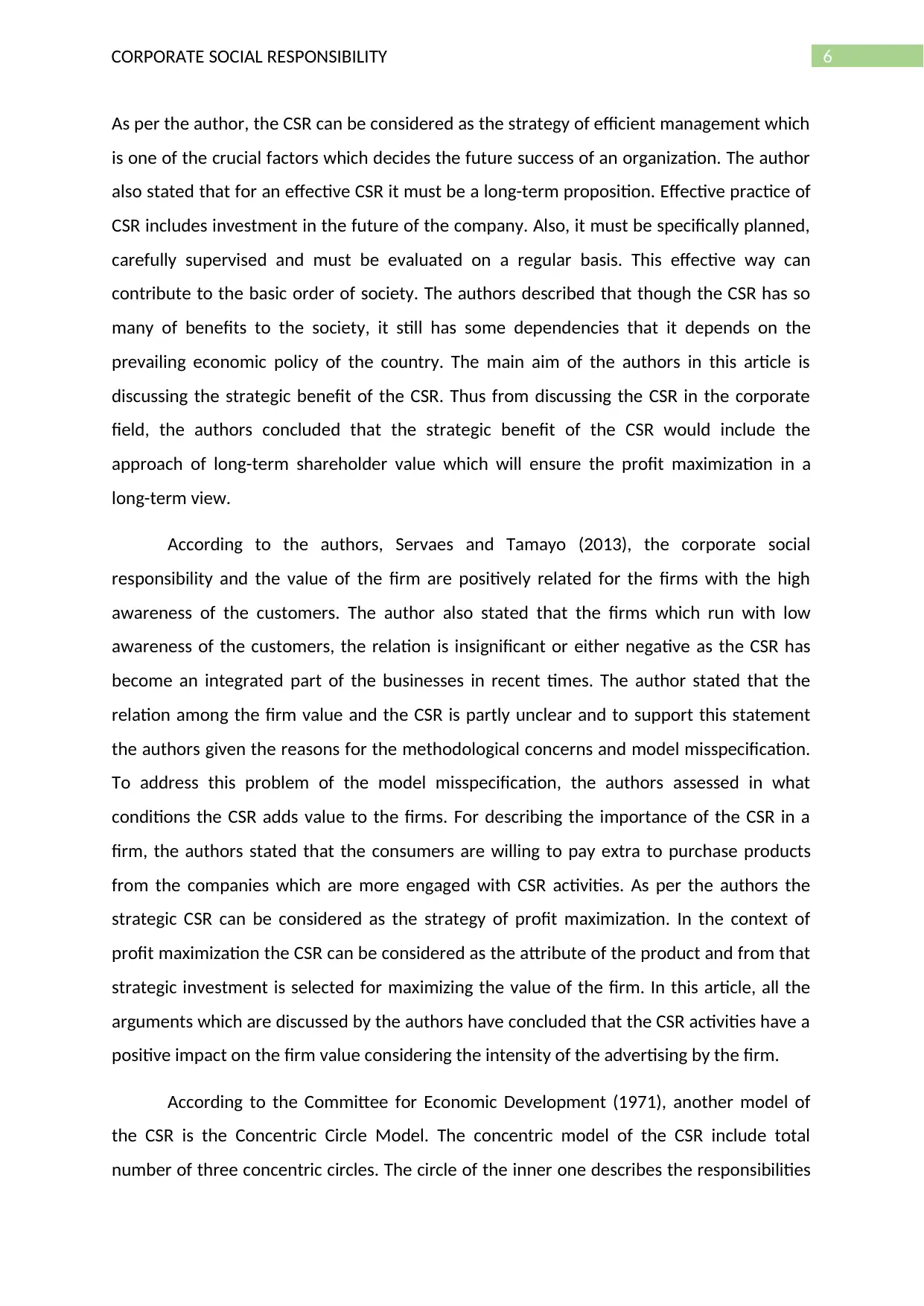
6CORPORATE SOCIAL RESPONSIBILITY
As per the author, the CSR can be considered as the strategy of efficient management which
is one of the crucial factors which decides the future success of an organization. The author
also stated that for an effective CSR it must be a long-term proposition. Effective practice of
CSR includes investment in the future of the company. Also, it must be specifically planned,
carefully supervised and must be evaluated on a regular basis. This effective way can
contribute to the basic order of society. The authors described that though the CSR has so
many of benefits to the society, it still has some dependencies that it depends on the
prevailing economic policy of the country. The main aim of the authors in this article is
discussing the strategic benefit of the CSR. Thus from discussing the CSR in the corporate
field, the authors concluded that the strategic benefit of the CSR would include the
approach of long-term shareholder value which will ensure the profit maximization in a
long-term view.
According to the authors, Servaes and Tamayo (2013), the corporate social
responsibility and the value of the firm are positively related for the firms with the high
awareness of the customers. The author also stated that the firms which run with low
awareness of the customers, the relation is insignificant or either negative as the CSR has
become an integrated part of the businesses in recent times. The author stated that the
relation among the firm value and the CSR is partly unclear and to support this statement
the authors given the reasons for the methodological concerns and model misspecification.
To address this problem of the model misspecification, the authors assessed in what
conditions the CSR adds value to the firms. For describing the importance of the CSR in a
firm, the authors stated that the consumers are willing to pay extra to purchase products
from the companies which are more engaged with CSR activities. As per the authors the
strategic CSR can be considered as the strategy of profit maximization. In the context of
profit maximization the CSR can be considered as the attribute of the product and from that
strategic investment is selected for maximizing the value of the firm. In this article, all the
arguments which are discussed by the authors have concluded that the CSR activities have a
positive impact on the firm value considering the intensity of the advertising by the firm.
According to the Committee for Economic Development (1971), another model of
the CSR is the Concentric Circle Model. The concentric model of the CSR include total
number of three concentric circles. The circle of the inner one describes the responsibilities
As per the author, the CSR can be considered as the strategy of efficient management which
is one of the crucial factors which decides the future success of an organization. The author
also stated that for an effective CSR it must be a long-term proposition. Effective practice of
CSR includes investment in the future of the company. Also, it must be specifically planned,
carefully supervised and must be evaluated on a regular basis. This effective way can
contribute to the basic order of society. The authors described that though the CSR has so
many of benefits to the society, it still has some dependencies that it depends on the
prevailing economic policy of the country. The main aim of the authors in this article is
discussing the strategic benefit of the CSR. Thus from discussing the CSR in the corporate
field, the authors concluded that the strategic benefit of the CSR would include the
approach of long-term shareholder value which will ensure the profit maximization in a
long-term view.
According to the authors, Servaes and Tamayo (2013), the corporate social
responsibility and the value of the firm are positively related for the firms with the high
awareness of the customers. The author also stated that the firms which run with low
awareness of the customers, the relation is insignificant or either negative as the CSR has
become an integrated part of the businesses in recent times. The author stated that the
relation among the firm value and the CSR is partly unclear and to support this statement
the authors given the reasons for the methodological concerns and model misspecification.
To address this problem of the model misspecification, the authors assessed in what
conditions the CSR adds value to the firms. For describing the importance of the CSR in a
firm, the authors stated that the consumers are willing to pay extra to purchase products
from the companies which are more engaged with CSR activities. As per the authors the
strategic CSR can be considered as the strategy of profit maximization. In the context of
profit maximization the CSR can be considered as the attribute of the product and from that
strategic investment is selected for maximizing the value of the firm. In this article, all the
arguments which are discussed by the authors have concluded that the CSR activities have a
positive impact on the firm value considering the intensity of the advertising by the firm.
According to the Committee for Economic Development (1971), another model of
the CSR is the Concentric Circle Model. The concentric model of the CSR include total
number of three concentric circles. The circle of the inner one describes the responsibilities
Paraphrase This Document
Need a fresh take? Get an instant paraphrase of this document with our AI Paraphraser

7CORPORATE SOCIAL RESPONSIBILITY
which are core to the business process in the respective of the CSR. Also the basic
responsibilities are included in this circle. The circle in the intermediary position considered
as the circle of ethics. This represents the responsibilities which are functions of economy
including sensitive awareness of basic ethics as well the changes in the priorities and social
values. As per the Committee for Economic Development the third circle is same with the
philanthropic circle. New and emerging responsibilities are represented through this circle.
This new and emerging responsibilities are needed to represent as it can involve broadly
and actively in improving the social environment.
(Figure 3: Concentric Model of CSR)
(Source: International Journal of Corporate Social Responsibility 2016)
Analysis of the NOKIA Case Study:
While considering the corporate social responsibility challenges faced by top firms,
NOKIA is one of them. Previously the NOKIA was one of the major consumer electronics
brands which sold mobile phones (Aspara et al. 2013). The NOKIA Corporation faced a very
much critical corporate social responsibility challenge in late of 2013 when it opted
Windows operating system for their mobile system while the majority of the mobile phone
brands opted Android operating system for their mobile devices. This challenge of the
corporate social responsibility was related to the activity of customer concern in this case
(Crane, Matten and Spence 2013). This challenge faced by the NOKIA Corporation due to the
dissatisfaction of the consumers of their mobile phone products. The main reason behind
which are core to the business process in the respective of the CSR. Also the basic
responsibilities are included in this circle. The circle in the intermediary position considered
as the circle of ethics. This represents the responsibilities which are functions of economy
including sensitive awareness of basic ethics as well the changes in the priorities and social
values. As per the Committee for Economic Development the third circle is same with the
philanthropic circle. New and emerging responsibilities are represented through this circle.
This new and emerging responsibilities are needed to represent as it can involve broadly
and actively in improving the social environment.
(Figure 3: Concentric Model of CSR)
(Source: International Journal of Corporate Social Responsibility 2016)
Analysis of the NOKIA Case Study:
While considering the corporate social responsibility challenges faced by top firms,
NOKIA is one of them. Previously the NOKIA was one of the major consumer electronics
brands which sold mobile phones (Aspara et al. 2013). The NOKIA Corporation faced a very
much critical corporate social responsibility challenge in late of 2013 when it opted
Windows operating system for their mobile system while the majority of the mobile phone
brands opted Android operating system for their mobile devices. This challenge of the
corporate social responsibility was related to the activity of customer concern in this case
(Crane, Matten and Spence 2013). This challenge faced by the NOKIA Corporation due to the
dissatisfaction of the consumers of their mobile phone products. The main reason behind
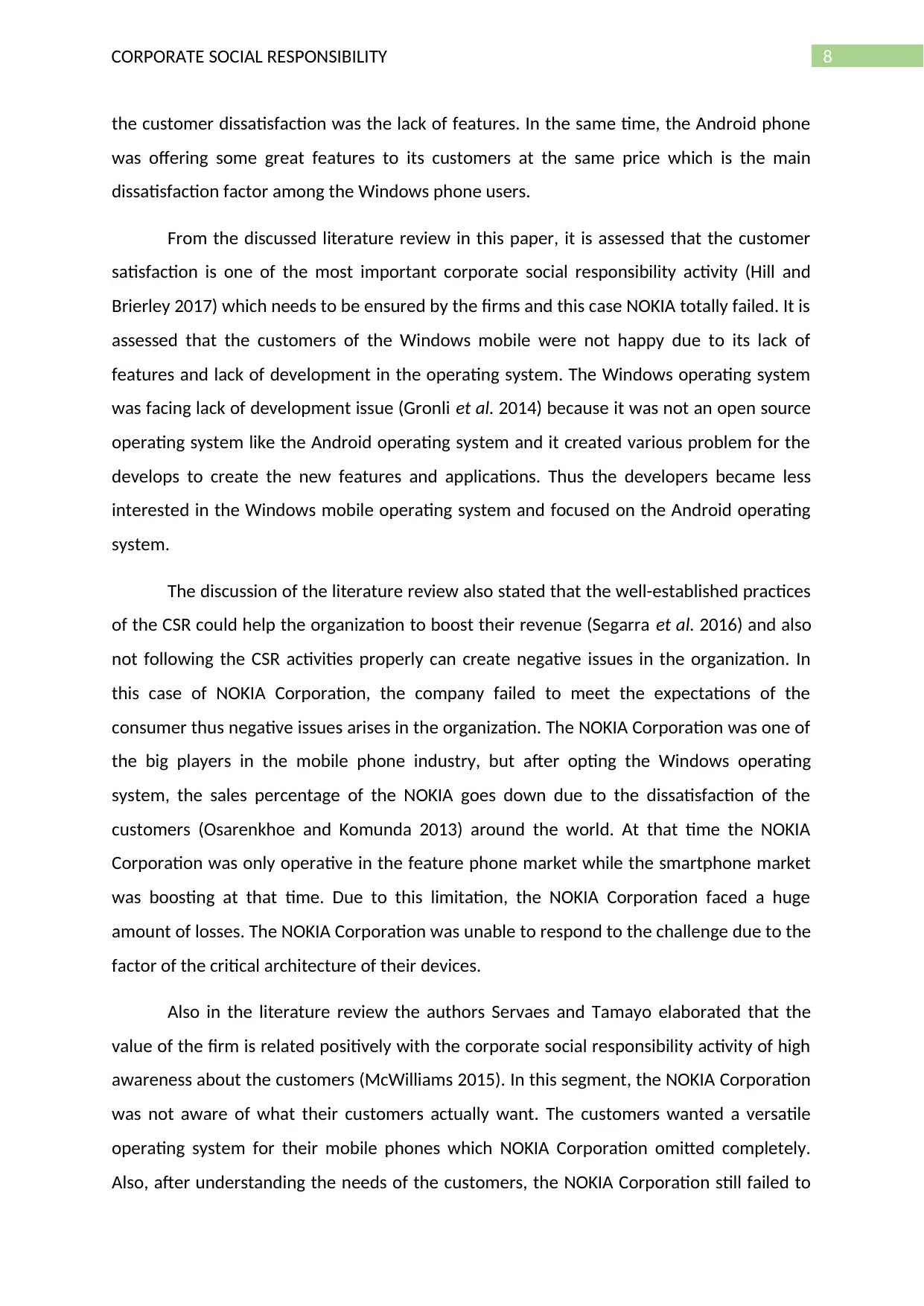
8CORPORATE SOCIAL RESPONSIBILITY
the customer dissatisfaction was the lack of features. In the same time, the Android phone
was offering some great features to its customers at the same price which is the main
dissatisfaction factor among the Windows phone users.
From the discussed literature review in this paper, it is assessed that the customer
satisfaction is one of the most important corporate social responsibility activity (Hill and
Brierley 2017) which needs to be ensured by the firms and this case NOKIA totally failed. It is
assessed that the customers of the Windows mobile were not happy due to its lack of
features and lack of development in the operating system. The Windows operating system
was facing lack of development issue (Gronli et al. 2014) because it was not an open source
operating system like the Android operating system and it created various problem for the
develops to create the new features and applications. Thus the developers became less
interested in the Windows mobile operating system and focused on the Android operating
system.
The discussion of the literature review also stated that the well-established practices
of the CSR could help the organization to boost their revenue (Segarra et al. 2016) and also
not following the CSR activities properly can create negative issues in the organization. In
this case of NOKIA Corporation, the company failed to meet the expectations of the
consumer thus negative issues arises in the organization. The NOKIA Corporation was one of
the big players in the mobile phone industry, but after opting the Windows operating
system, the sales percentage of the NOKIA goes down due to the dissatisfaction of the
customers (Osarenkhoe and Komunda 2013) around the world. At that time the NOKIA
Corporation was only operative in the feature phone market while the smartphone market
was boosting at that time. Due to this limitation, the NOKIA Corporation faced a huge
amount of losses. The NOKIA Corporation was unable to respond to the challenge due to the
factor of the critical architecture of their devices.
Also in the literature review the authors Servaes and Tamayo elaborated that the
value of the firm is related positively with the corporate social responsibility activity of high
awareness about the customers (McWilliams 2015). In this segment, the NOKIA Corporation
was not aware of what their customers actually want. The customers wanted a versatile
operating system for their mobile phones which NOKIA Corporation omitted completely.
Also, after understanding the needs of the customers, the NOKIA Corporation still failed to
the customer dissatisfaction was the lack of features. In the same time, the Android phone
was offering some great features to its customers at the same price which is the main
dissatisfaction factor among the Windows phone users.
From the discussed literature review in this paper, it is assessed that the customer
satisfaction is one of the most important corporate social responsibility activity (Hill and
Brierley 2017) which needs to be ensured by the firms and this case NOKIA totally failed. It is
assessed that the customers of the Windows mobile were not happy due to its lack of
features and lack of development in the operating system. The Windows operating system
was facing lack of development issue (Gronli et al. 2014) because it was not an open source
operating system like the Android operating system and it created various problem for the
develops to create the new features and applications. Thus the developers became less
interested in the Windows mobile operating system and focused on the Android operating
system.
The discussion of the literature review also stated that the well-established practices
of the CSR could help the organization to boost their revenue (Segarra et al. 2016) and also
not following the CSR activities properly can create negative issues in the organization. In
this case of NOKIA Corporation, the company failed to meet the expectations of the
consumer thus negative issues arises in the organization. The NOKIA Corporation was one of
the big players in the mobile phone industry, but after opting the Windows operating
system, the sales percentage of the NOKIA goes down due to the dissatisfaction of the
customers (Osarenkhoe and Komunda 2013) around the world. At that time the NOKIA
Corporation was only operative in the feature phone market while the smartphone market
was boosting at that time. Due to this limitation, the NOKIA Corporation faced a huge
amount of losses. The NOKIA Corporation was unable to respond to the challenge due to the
factor of the critical architecture of their devices.
Also in the literature review the authors Servaes and Tamayo elaborated that the
value of the firm is related positively with the corporate social responsibility activity of high
awareness about the customers (McWilliams 2015). In this segment, the NOKIA Corporation
was not aware of what their customers actually want. The customers wanted a versatile
operating system for their mobile phones which NOKIA Corporation omitted completely.
Also, after understanding the needs of the customers, the NOKIA Corporation still failed to
⊘ This is a preview!⊘
Do you want full access?
Subscribe today to unlock all pages.

Trusted by 1+ million students worldwide

9CORPORATE SOCIAL RESPONSIBILITY
address the needs of the customers due to the limitation of their operating system. As the
NOKIA Corporation failed to address the needs of the customers so many times, the
consumers started to opt the Android and Apple iOS phones over the Windows phone
(Silberschatz, Gagne and Galvin 2018) which lead the NOKIA Corporation and the Windows
mobile operating System towards a great failure.
After the failure in the smartphone industry with the Windows operating system, it
was high time for the NOKIA Corporation to try again in the smartphone industry. For this
time the NOKIA Corporation must not repeat the same mistake which was done by it
previously, and that mistake was not fulfilling the demands of the stakeholders (Amran and
Keat Ooi 2014). In this case, the stakeholders were the consumers or the customers. Also,
the developers can be considered as a stakeholder in this case. As the developers are
internal stakeholders of organization (Ahlan, Kartiwi and Sukmana 2015), the satisfaction of
the developers also create an optimal work environment in the organization which is
another corporate social responsibility based activity. The NOKIA Corporation assessed that
it was not possible on that time to fulfil the demands of the customers and the developers
with the implementation of the same Windows operating system again for their mobile
devices. For this reason, they opted the Android operating system from the Google which
was very much popular at that time and also it was very much easy to handle.
Using the practices of the corporate social responsibility, they shifted their focus on
the demands of the users and the satisfaction of the consumers (Epstein 2018) rather than
providing uniqueness which was their focus earlier. The NOKIA Corporation followed the
practice or the activity of the customer satisfaction of the corporate social responsibility and
actually they got success in this case. The smartphones of the NOKIA Corporation is live
again, and this time they were able to meet the demands of the customers by using the
Android operating system as major of the popular and important applications is available in
the Android platform (Ma, Gu and Wang 2014) and the users of the NOKIA mobile phones
can use this application in their phones. Previously NOKIA mobile users were unable to use
these applications in their phone which is now possible. Also, as the NOKIA opted the
Android operating system over the Windows operating system it also helped the developers
in the development process as the Android operating system is an open source operating
system (Ahmad et al. 2013), unlike the Windows operating system. As the development
address the needs of the customers due to the limitation of their operating system. As the
NOKIA Corporation failed to address the needs of the customers so many times, the
consumers started to opt the Android and Apple iOS phones over the Windows phone
(Silberschatz, Gagne and Galvin 2018) which lead the NOKIA Corporation and the Windows
mobile operating System towards a great failure.
After the failure in the smartphone industry with the Windows operating system, it
was high time for the NOKIA Corporation to try again in the smartphone industry. For this
time the NOKIA Corporation must not repeat the same mistake which was done by it
previously, and that mistake was not fulfilling the demands of the stakeholders (Amran and
Keat Ooi 2014). In this case, the stakeholders were the consumers or the customers. Also,
the developers can be considered as a stakeholder in this case. As the developers are
internal stakeholders of organization (Ahlan, Kartiwi and Sukmana 2015), the satisfaction of
the developers also create an optimal work environment in the organization which is
another corporate social responsibility based activity. The NOKIA Corporation assessed that
it was not possible on that time to fulfil the demands of the customers and the developers
with the implementation of the same Windows operating system again for their mobile
devices. For this reason, they opted the Android operating system from the Google which
was very much popular at that time and also it was very much easy to handle.
Using the practices of the corporate social responsibility, they shifted their focus on
the demands of the users and the satisfaction of the consumers (Epstein 2018) rather than
providing uniqueness which was their focus earlier. The NOKIA Corporation followed the
practice or the activity of the customer satisfaction of the corporate social responsibility and
actually they got success in this case. The smartphones of the NOKIA Corporation is live
again, and this time they were able to meet the demands of the customers by using the
Android operating system as major of the popular and important applications is available in
the Android platform (Ma, Gu and Wang 2014) and the users of the NOKIA mobile phones
can use this application in their phones. Previously NOKIA mobile users were unable to use
these applications in their phone which is now possible. Also, as the NOKIA opted the
Android operating system over the Windows operating system it also helped the developers
in the development process as the Android operating system is an open source operating
system (Ahmad et al. 2013), unlike the Windows operating system. As the development
Paraphrase This Document
Need a fresh take? Get an instant paraphrase of this document with our AI Paraphraser
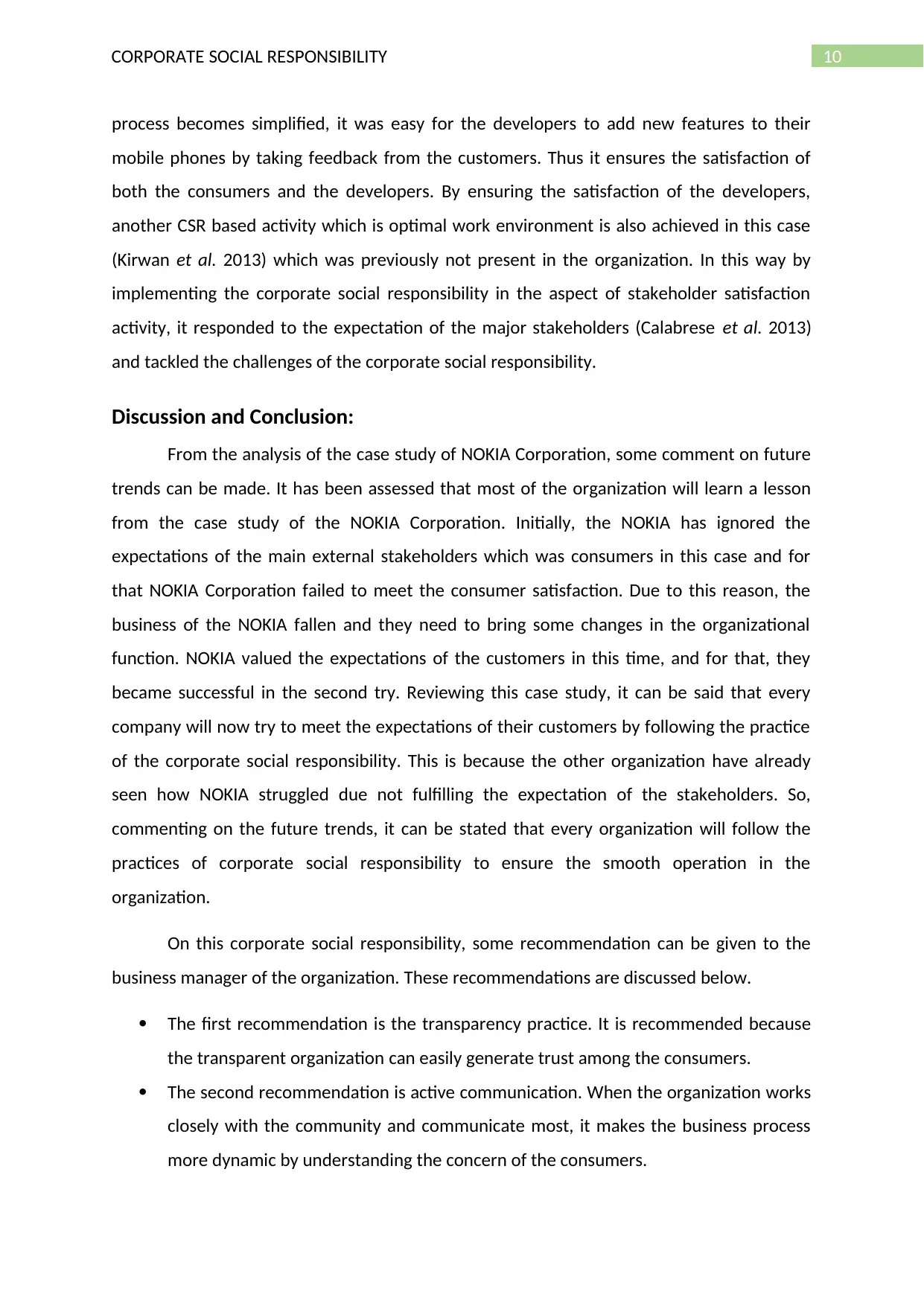
10CORPORATE SOCIAL RESPONSIBILITY
process becomes simplified, it was easy for the developers to add new features to their
mobile phones by taking feedback from the customers. Thus it ensures the satisfaction of
both the consumers and the developers. By ensuring the satisfaction of the developers,
another CSR based activity which is optimal work environment is also achieved in this case
(Kirwan et al. 2013) which was previously not present in the organization. In this way by
implementing the corporate social responsibility in the aspect of stakeholder satisfaction
activity, it responded to the expectation of the major stakeholders (Calabrese et al. 2013)
and tackled the challenges of the corporate social responsibility.
Discussion and Conclusion:
From the analysis of the case study of NOKIA Corporation, some comment on future
trends can be made. It has been assessed that most of the organization will learn a lesson
from the case study of the NOKIA Corporation. Initially, the NOKIA has ignored the
expectations of the main external stakeholders which was consumers in this case and for
that NOKIA Corporation failed to meet the consumer satisfaction. Due to this reason, the
business of the NOKIA fallen and they need to bring some changes in the organizational
function. NOKIA valued the expectations of the customers in this time, and for that, they
became successful in the second try. Reviewing this case study, it can be said that every
company will now try to meet the expectations of their customers by following the practice
of the corporate social responsibility. This is because the other organization have already
seen how NOKIA struggled due not fulfilling the expectation of the stakeholders. So,
commenting on the future trends, it can be stated that every organization will follow the
practices of corporate social responsibility to ensure the smooth operation in the
organization.
On this corporate social responsibility, some recommendation can be given to the
business manager of the organization. These recommendations are discussed below.
The first recommendation is the transparency practice. It is recommended because
the transparent organization can easily generate trust among the consumers.
The second recommendation is active communication. When the organization works
closely with the community and communicate most, it makes the business process
more dynamic by understanding the concern of the consumers.
process becomes simplified, it was easy for the developers to add new features to their
mobile phones by taking feedback from the customers. Thus it ensures the satisfaction of
both the consumers and the developers. By ensuring the satisfaction of the developers,
another CSR based activity which is optimal work environment is also achieved in this case
(Kirwan et al. 2013) which was previously not present in the organization. In this way by
implementing the corporate social responsibility in the aspect of stakeholder satisfaction
activity, it responded to the expectation of the major stakeholders (Calabrese et al. 2013)
and tackled the challenges of the corporate social responsibility.
Discussion and Conclusion:
From the analysis of the case study of NOKIA Corporation, some comment on future
trends can be made. It has been assessed that most of the organization will learn a lesson
from the case study of the NOKIA Corporation. Initially, the NOKIA has ignored the
expectations of the main external stakeholders which was consumers in this case and for
that NOKIA Corporation failed to meet the consumer satisfaction. Due to this reason, the
business of the NOKIA fallen and they need to bring some changes in the organizational
function. NOKIA valued the expectations of the customers in this time, and for that, they
became successful in the second try. Reviewing this case study, it can be said that every
company will now try to meet the expectations of their customers by following the practice
of the corporate social responsibility. This is because the other organization have already
seen how NOKIA struggled due not fulfilling the expectation of the stakeholders. So,
commenting on the future trends, it can be stated that every organization will follow the
practices of corporate social responsibility to ensure the smooth operation in the
organization.
On this corporate social responsibility, some recommendation can be given to the
business manager of the organization. These recommendations are discussed below.
The first recommendation is the transparency practice. It is recommended because
the transparent organization can easily generate trust among the consumers.
The second recommendation is active communication. When the organization works
closely with the community and communicate most, it makes the business process
more dynamic by understanding the concern of the consumers.
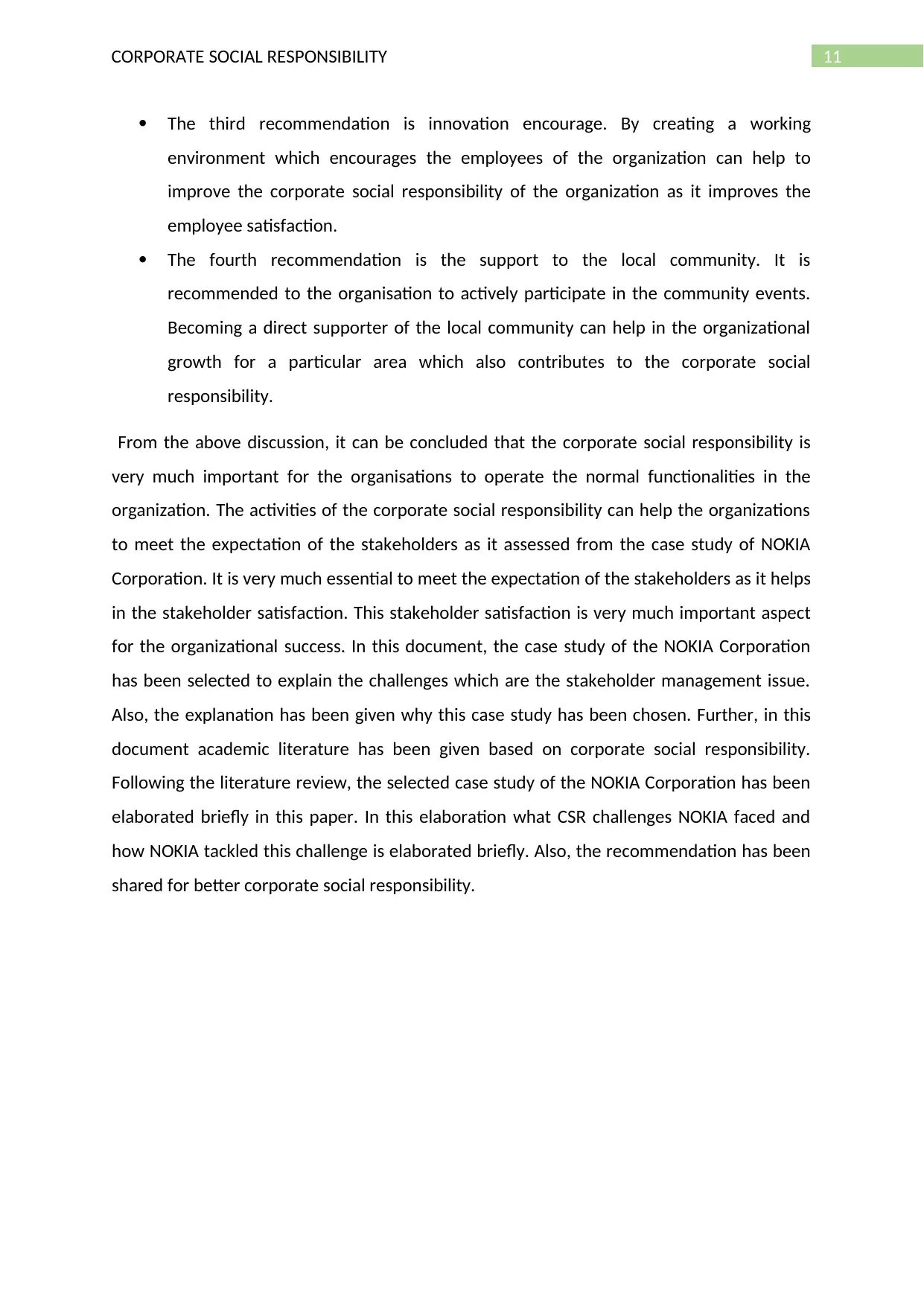
11CORPORATE SOCIAL RESPONSIBILITY
The third recommendation is innovation encourage. By creating a working
environment which encourages the employees of the organization can help to
improve the corporate social responsibility of the organization as it improves the
employee satisfaction.
The fourth recommendation is the support to the local community. It is
recommended to the organisation to actively participate in the community events.
Becoming a direct supporter of the local community can help in the organizational
growth for a particular area which also contributes to the corporate social
responsibility.
From the above discussion, it can be concluded that the corporate social responsibility is
very much important for the organisations to operate the normal functionalities in the
organization. The activities of the corporate social responsibility can help the organizations
to meet the expectation of the stakeholders as it assessed from the case study of NOKIA
Corporation. It is very much essential to meet the expectation of the stakeholders as it helps
in the stakeholder satisfaction. This stakeholder satisfaction is very much important aspect
for the organizational success. In this document, the case study of the NOKIA Corporation
has been selected to explain the challenges which are the stakeholder management issue.
Also, the explanation has been given why this case study has been chosen. Further, in this
document academic literature has been given based on corporate social responsibility.
Following the literature review, the selected case study of the NOKIA Corporation has been
elaborated briefly in this paper. In this elaboration what CSR challenges NOKIA faced and
how NOKIA tackled this challenge is elaborated briefly. Also, the recommendation has been
shared for better corporate social responsibility.
The third recommendation is innovation encourage. By creating a working
environment which encourages the employees of the organization can help to
improve the corporate social responsibility of the organization as it improves the
employee satisfaction.
The fourth recommendation is the support to the local community. It is
recommended to the organisation to actively participate in the community events.
Becoming a direct supporter of the local community can help in the organizational
growth for a particular area which also contributes to the corporate social
responsibility.
From the above discussion, it can be concluded that the corporate social responsibility is
very much important for the organisations to operate the normal functionalities in the
organization. The activities of the corporate social responsibility can help the organizations
to meet the expectation of the stakeholders as it assessed from the case study of NOKIA
Corporation. It is very much essential to meet the expectation of the stakeholders as it helps
in the stakeholder satisfaction. This stakeholder satisfaction is very much important aspect
for the organizational success. In this document, the case study of the NOKIA Corporation
has been selected to explain the challenges which are the stakeholder management issue.
Also, the explanation has been given why this case study has been chosen. Further, in this
document academic literature has been given based on corporate social responsibility.
Following the literature review, the selected case study of the NOKIA Corporation has been
elaborated briefly in this paper. In this elaboration what CSR challenges NOKIA faced and
how NOKIA tackled this challenge is elaborated briefly. Also, the recommendation has been
shared for better corporate social responsibility.
⊘ This is a preview!⊘
Do you want full access?
Subscribe today to unlock all pages.

Trusted by 1+ million students worldwide
1 out of 14
Related Documents
Your All-in-One AI-Powered Toolkit for Academic Success.
+13062052269
info@desklib.com
Available 24*7 on WhatsApp / Email
![[object Object]](/_next/static/media/star-bottom.7253800d.svg)
Unlock your academic potential
Copyright © 2020–2025 A2Z Services. All Rights Reserved. Developed and managed by ZUCOL.





